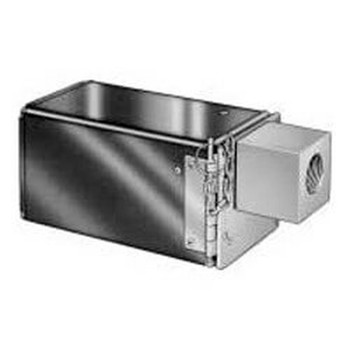Description
Compact flame detector for use with flame safeguard controls with ultraviolet amplifiers.
Features
- Use with Honeywell Flame Safeguard primary safety controls and burners requiring ultraviolet flame detection.
- C7027 mounts on a 1/2 in. sighting pipe by using an integral collar.
- Detectors can be wired in parallel for difficult sighting applications.
- C7027 seals against pressures up to 5 psi (34.5kPa) when correctly installed.
- Allows for blast tube mounting due to compact size.
- C7044 mounts with a two screw bracket.
- The C7044 UV sensor tube is enclosed in a stainless steel housing.
- C7044 has the capability of side or end viewing in flame monitoring applications.
| Product Specifications | |
| Application | Coal fired burners; Gas fired burners; Oil fired burners |
| Use With | Flame Amplifiers: R7249A, B, R7849A, B, R7749B, R7259, R7290 |
| Comments | Detects ultraviolet radiation in flames |
| Mounting | Integral nut for 1/2 in. sighting pipe. |
| Approvals, Underwriters Laboratories Inc. | Listed: File No. MP268, Guide No. MCCZ |
| Approvals, Canadian Standards Association | Certified: Master Report LR95329-1 |
| Electrical Connections | 2 NEC Class 1 lead wires |
| Approvals, Swiss RE | Acceptable |
| Approvals, Factory Mutual | Approved: Report No. 24181.03 |
| Ambient Temperature Range (F) | 0 F to 215 F |
| Ambient Temperature Range (C) | -18 C to +102 C |
| Lead Length (in.) | 96 in. |
| Lead Length (mm) | 2438 mm |
Signs your detector could be failing
Honeywell Ultraviolet (UV) Flame Detectors are reliable and widely-used components in various combustion systems, including boilers, furnaces, and industrial applications. These detectors play a crucial role in monitoring the presence of a flame and ensuring safe and efficient operation. However, like any other mechanical or electronic device, UV flame detectors can experience issues and eventually fail over time. Recognizing the signs of potential failure is essential for maintaining proper system functionality and avoiding potential hazards.
- Erratic or Intermittent Operation One of the earliest indicators of a failing UV flame detector is erratic or intermittent operation. If the detector seems to be functioning correctly at times but then randomly fails to respond or sends inconsistent signals, it could be a sign that the components are starting to degrade. This behavior can lead to frequent system shutdowns or lockouts, causing inconvenience and potential safety concerns.
- Delayed or Slow Response Time A healthy UV flame detector should respond promptly to the presence or absence of a flame. If you notice a delayed or slow response time when the flame is established or extinguished, it could be an indication that the detector's sensitivity is decreasing. This issue may be caused by a variety of factors, including degradation of the UV sensor, aging of internal components, or contamination on the detector's viewing window.
- False Flame Signals In some cases, a failing UV flame detector may generate false flame signals, indicating the presence of a flame when there is none. This issue can be particularly problematic as it can lead to potential safety hazards or inefficient operation of the combustion system. False flame signals can be caused by electronic interference, aging components, or even external light sources interfering with the detector's operation.
- Frequent Lockouts or Shutdowns If your combustion system experiences frequent lockouts or shutdowns due to the UV flame detector's inability to sense or confirm the presence of a flame, it could be a clear sign that the detector is failing. These repeated lockouts or shutdowns can be frustrating and may require frequent manual resets or interventions, indicating the need for detector replacement or maintenance.
- Visual Inspection In addition to monitoring the operational behavior of the UV flame detector, it's also essential to perform regular visual inspections. Look for signs of physical damage, such as cracks or discoloration on the detector's viewing window or housing. Also, check for any buildup of dirt, soot, or other contaminants that could interfere with the detector's ability to accurately sense the UV radiation produced by the flame.
If you notice any of these signs or suspect that your Honeywell UV Flame Detector may be failing, it's crucial to take prompt action. Consult with a qualified technician or refer to the manufacturer's guidelines for proper maintenance, troubleshooting, and potential replacement procedures.
Regular maintenance and timely replacement of UV flame detectors can help ensure the safe and efficient operation of your combustion system while minimizing the risk of potential hazards or costly downtime. By being proactive and attentive to the signs of potential failure, you can stay ahead of potential issues and maintain the reliability of your Honeywell UV Flame Detector.








